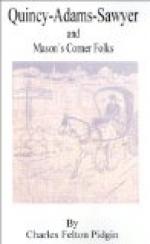Both men walked along silently until they reached Mrs. Hawkins’ boarding house; here the Professor stopped and bade ’Zekiel good night. After doing so he added:
“Pettengill, you and me must jine agin the common enemy. This town ain’t big enough to hold us and this destroyer of our happiness, and we must find some way of smokin’ him out.”
The slumbers of both ’Zekiel and the Professor were broken when the jolly party returned home after midnight. ’Zekiel recalled Hiram’s description of the arrangement of seats, and another deep sigh escaped him; but this time there were no leafless trees and winter wind to supply an echo.
The Professor’s half-awakened mind travelled in very different channels. He imagined himself engaged in several verbal disputes with a number of fisticuff encounters in which he invariably proved to be too much for the city fellow. Just before he sank again into a deep sleep he imagined that the entire population of Mason’s Corner escorted a certain young man forcibly to the railroad station at Eastborough Centre and put him in charge of the expressman, to be delivered in Boston. And that young man, in the Professor’s dream, had a tag tied to the lapel of his coat upon which was written, “Quincy Adams Sawyer.”
CHAPTER II.
MASON’S CORNER FOLKS.
In 186— the town of Eastborough was located in the southeastern part of Massachusetts, in the county of Normouth. It was a large town, being fully five miles wide from east to west and from five to seven miles long, the northern and southern boundaries being very irregular.
The town contained three villages; the western one being known as West Eastborough, the middle one as Eastborough Centre, and the easterly one as Mason’s Corner. West Eastborough was exclusively a farming section, having no store or post office. As the extreme western boundary was only a mile and a half from Eastborough Centre, the farmers of the western section of the town were well accommodated at the Centre. The middle section contained the railroad station, at which five trains a day, each way, to and from Boston, made regular stops. The Centre contained the Town Hall, two churches, a hotel, and express office, a bank, newspaper office, and several general stores. Not very far from the hotel, on a side road, was the Almshouse, or Poorhouse, as it was always called by the citizens of Eastborough.
Between the Centre and Mason’s Corner was a long interval of three miles. The land bordering the lower and most direct route was, to a great extent, hilly and rocky, or full of sand and clay pits. The upper and longest road ran through a more fertile section. The village of Mason’s Corner contained the best arable land in the town, and the village had increased in population and wealth much faster than the other sections of the town. To the east of the village of Mason’s Corner lay the town of Montrose, and beyond that town was situated the thriving city of Cottonton, devoted largely, as its name indicated, to the textile manufacturing industries.




